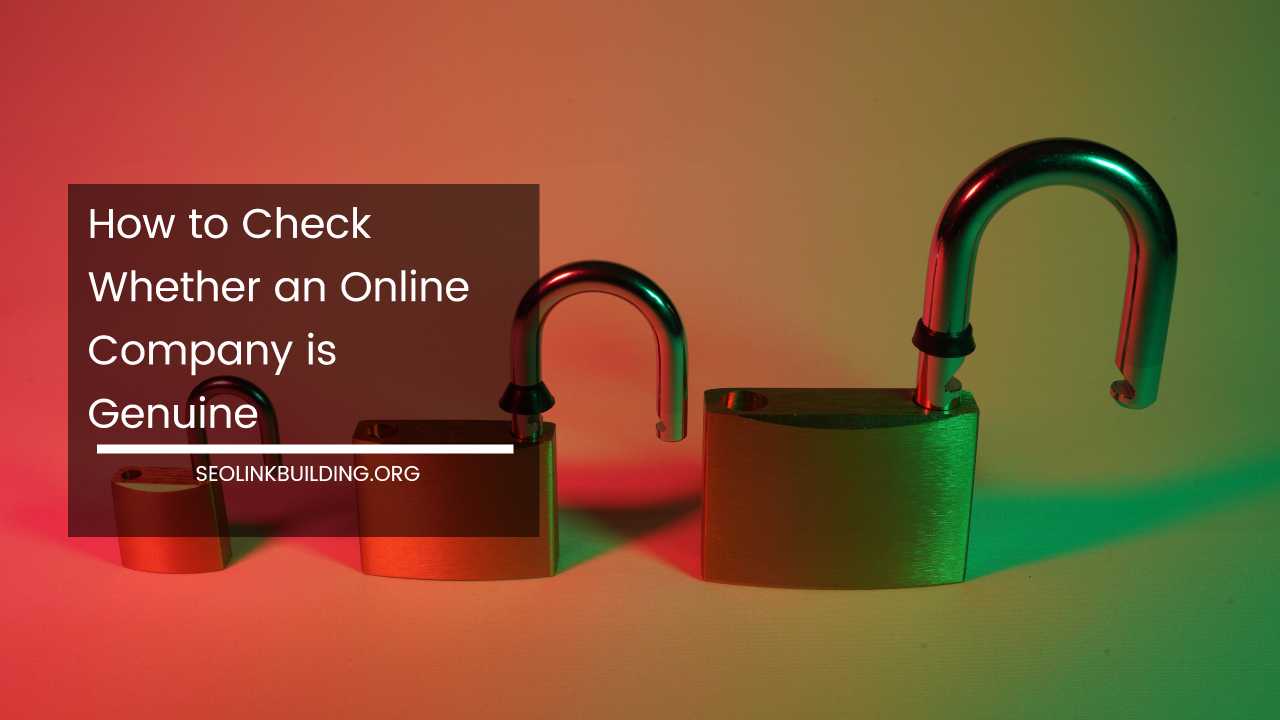How to Check Whether an Online Company is Genuine

How to Check Whether an Online Company is Genuine: Your Guide to Safe Shopping in the Digital Age
The internet has become an undeniably essential part of our lives. From hailing a cab to ordering groceries, its convenience extends to the realm of shopping as well.
Online stores offer a vast array of products and services at competitive prices, accessible from the comfort of your couch. However, this ease of access comes with a hidden threat: the possibility of encountering fraudulent online companies.
Before you hit “purchase” and enter your sensitive financial information, it’s crucial to verify the legitimacy of the company you’re dealing with.
Falling victim to an online scam can result in not only financial loss but also identity theft and emotional distress.
This comprehensive guide equips you with the knowledge and tools to confidently assess online businesses and avoid such pitfalls.
Unveiling the Website: Scrutinize Every Detail
The company’s website serves as your first point of contact, offering valuable insights into its legitimacy. Here’s what you need to pay close attention to:
-
Security Essentials: Look for a secure connection signified by a closed padlock icon and “https://” at the beginning of the URL. This indicates that the website encrypts your data using Secure Sockets Layer (SSL) technology, protecting it from being intercepted by hackers as it travels between your device and the company’s server.
-
Professionalism Speaks Volumes: A well-designed website with clear navigation, high-quality images, and concise, grammatically correct information is a positive sign. Conversely, a poorly designed site riddled with typos, grammatical errors, blurry or generic stock photos, and a confusing layout suggests a lack of professionalism and potentially, legitimacy.
-
Contact Transparency: A genuine company will prominently display a physical address, phone number, and email address for customer service inquiries. Be wary of companies with only an email address or a contact form, especially if the email address seems generic (e.g., [email address removed]) or unrelated to the company name. A physical address allows you to verify the company’s existence through services like Google Maps.
-
About Us: Unveiling the Company’s Story: The “About Us” page should provide a clear picture of the company’s background, mission, and the team behind it. Look for information about the company’s history, its core values, and the expertise of its employees. A lack of information or generic content (“We are a leading provider of…” ) raises red flags.
-
Customer Reviews: The Voice of Experience: Independent customer reviews on reputable platforms like Trustpilot, Sitejabber, or the Better Business Bureau (BBB) website can offer valuable insights into a company’s customer service, product quality, and overall legitimacy. Look for reviews that discuss specific experiences, both positive and negative. A company with a consistent pattern of negative reviews or an unusually high number of positive reviews that seem suspiciously similar should be approached with caution.
-
Unrealistic Offers & Pressure Tactics: Be skeptical of companies offering unbelievably low prices or deals that seem “too good to be true.” These are classic tactics used by scammers to lure unsuspecting customers. Similarly, companies that pressure you to buy immediately with limited-time offers or scare tactics (“This offer expires in 5 minutes!”) are likely illegitimate. Legitimate businesses understand that customers need time to research and make informed decisions.
Beyond the Surface: Delving Deeper into Legitimacy
While the website offers a wealth of information, don’t stop your investigation there. Here are further steps to solidify your trust:
-
Search Engine Investigation: Use Google or another search engine to find out more about the company. Look for news articles, independent reviews on websites not affiliated with the company, or complaints filed against the company with the BBB or similar organizations.
-
Social Media Presence: Check if the company has a social media presence on platforms like Facebook, Twitter, or Instagram. A legitimate company will typically have active social media accounts with real followers and engagement. Look for the number of followers, the quality of interactions, and the types of content the company posts. Does the company respond to comments and messages from customers in a timely and professional manner?
-
Business Registration Verification: Depending on your location, you might be able to verify the company’s registration with government agencies or business directories. Websites like “https://www.whois.com/” can sometimes reveal information about a domain name’s registration, including the registrant’s name and creation date. A recent domain registration date (within the past few months) could be a red flag.
Payment Methods & Buyer Protection: Safeguarding Your Finances
- Secure Payment Gateways: When making online purchases, look for reputable payment gateways like PayPal, Stripe, or Amazon Pay. These companies offer buyer protection mechanisms, allowing you to dispute fraudulent charges and potentially recover your funds if you encounter an issue with your purchase. Avoid companies requiring direct bank transfers, obscure payment processors, or virtual credit card numbers. These methods offer minimal to no buyer protection and are often favored by scammers.
- Return Policy & Customer Service: A clear and fair return policy is a hallmark of a legitimate company. Look for a dedicated customer service section with information on how to contact them (phone number, email address, live chat options), their typical response time for inquiries, and any return or exchange policies. Consider factors like whether the company offers free returns, how long you have to return an item, and under what circumstances a return would be accepted (e.g., unopened items, items with manufacturing defects).
Warning Signs: The Red Flags of Online Scams
Here are some red flags that should immediately make you suspicious of an online company:
-
Generic Products & Images: Companies selling generic products often found on multiple websites with stolen images are likely scams. Scammers often use generic product descriptions and low-quality, generic stock photos to avoid detection.
-
Outlandish Claims & Guarantees: Promises of miracle cures, instant weight loss with minimal effort, or guaranteed financial success are classic signs of a scam. Be wary of companies making claims that seem too good to be true, especially those backed by flimsy or nonexistent scientific evidence.
-
High-Pressure Sales Tactics: Companies that pressure you to buy immediately or use scare tactics like limited-time offers or warnings about running out of stock are likely illegitimate. Legitimate businesses understand that customers need time to consider their options, compare prices, and make informed decisions.
-
Request for Excessive Personal Information: Legitimate companies typically only require information necessary to process your order, such as your name, shipping address, billing address, and email address. Be wary of companies asking for excessive personal information like your social security number, bank account details, or your date of birth.
-
Undeliverable Contact Information: If the company’s contact information includes a phone number that goes straight to voicemail, an email address that bounces back, or a physical address that leads to a vacant building or unrelated business, it’s a strong indication of a scam.
Taking Action if Scammed: Reclaiming Your Losses
Unfortunately, even with careful precautions, there’s always a chance of encountering a scam. If you suspect you’ve been scammed, don’t hesitate to take action:
-
Report the Scam: Report the fraudulent company to the authorities, such as the Federal Trade Commission (FTC) in the United States or your local consumer protection agency. Reporting scams helps to track down perpetrators and prevent others from falling victim.
-
Dispute the Charge: Contact your bank or credit card company and file a dispute for the fraudulent charge. Explain the situation and provide any documentation you have, such as screenshots or emails from the company.
-
Change Passwords: If you used the same password on the fraudulent website that you use on other websites, immediately change your passwords for those accounts to prevent further compromises.
-
Educate Others: Share your experience with friends, family, and online communities to raise awareness about online scams and help others avoid similar pitfalls.
Building Confidence: Tips for Savvy Online Shopping
By following these tips and remaining vigilant, you can significantly reduce your risk of encountering online scams and become a more confident online shopper:
-
Shop at Reputable Retailers: Stick to established online retailers with a proven track record. Look for companies with positive customer reviews and a strong online presence.
-
Compare Prices: Don’t be lured in by unbelievably low prices. Use price comparison tools to get a sense of the typical market value for the product you’re interested in.
-
Read Reviews: Before making a purchase, take time to read customer reviews on independent platforms to get a sense of the company’s customer service, product quality, and overall legitimacy.
-
Use Credit Cards for Online Purchases: When possible, use credit cards for online purchases as they typically offer greater buyer protection compared to debit cards.
-
Beware of Phishing Emails: Phishing emails attempt to trick you into clicking on malicious links or revealing personal information by impersonating legitimate companies. Be wary of unsolicited emails, even if they appear to be from a familiar brand. Don’t click on links or attachments in suspicious emails.
-
Install Security Software: Keep your computer and mobile devices up-to-date with the latest security software to protect yourself from malware and online threats.
Conclusion: Empowered Shopping in the Digital Age
The digital marketplace offers a vast array of opportunities, but it also comes with inherent risks. By following the steps outlined in this comprehensive guide, you can navigate the online shopping world with confidence and minimize your chances of encountering scams.
Remember, a little extra caution goes a long way in protecting your finances and personal information.
Beyond the Basics: Advanced Techniques for Savvy Shoppers
While the core principles remain the same, some advanced techniques can further enhance your online security:
-
Reverse Image Search: If you’re unsure about the legitimacy of a product image, use a reverse image search tool like Google Images to see if the same image appears on other websites. This can help identify companies selling generic products with stolen images.
-
Check for Trust Seals: Look for trust seals from reputable organizations like Verisign, McAfee Secure, or Norton Secured on a website’s homepage or checkout page. These seals indicate that the website has undergone security checks and adheres to certain security standards. However, the presence of a trust seal alone doesn’t guarantee legitimacy, so use it as one factor among many in your evaluation.
-
Independent Payment Processors: Consider using independent payment processors like escrow services for high-value transactions, especially when dealing with unknown companies. Escrow services hold the payment in trust until both parties fulfill their obligations.
-
Read Online Security Reviews: There are websites dedicated to reviewing the security practices of online businesses. Consulting these resources can provide valuable insights into a company’s commitment to data protection and customer security.
The Evolving Landscape of Online Scams
The world of online scams is constantly evolving. Here are some emerging trends to be aware of:
-
Social Media Scams: Scammers are increasingly targeting social media users through fake accounts, impersonating legitimate businesses, or spreading misinformation about miracle products or investment opportunities.
-
Fake Review Rings: Some companies pay for fake positive reviews or manipulate their rating systems to deceive customers. Be wary of websites with an abundance of glowing reviews that lack detail or seem suspiciously similar.
-
Subscription Traps: Scammers may lure you into signing up for a free trial with hidden recurring charges. Always read the fine print before entering your credit card information and be aware of cancellation policies.
-
Phishing Attacks via SMS: Smishing, or phishing via SMS text messages, is a growing threat. Don’t click on links in suspicious text messages, even if they appear to be from your bank or credit card company.
Final Word: A Final Word on Safe Online Shopping
By adopting a cautious and informed approach, you can navigate the online marketplace with confidence. Remember, if something seems too good to be true, it probably is.
Don’t hesitate to walk away from a deal that raises any doubts. By following these tips and staying vigilant, you can make informed purchasing decisions and enjoy the vast array of benefits that online shopping offers.
Empowering Yourself: Resources for Further Exploration
Here are some valuable resources to help you stay informed and continue learning about online safety:
- Federal Trade Commission (FTC): https://www.ftc.gov/ – The FTC website provides comprehensive information on various online scams and how to protect yourself.
- Better Business Bureau (BBB): https://www.bbb.org/search – The BBB offers scam alerts, business reviews, and tips for safe online shopping.
- National Cyber Security Alliance: https://staysafeonline.org/ – This non-profit organization provides resources and educational materials on online safety and security.
By familiarizing yourself with these resources, you can further safeguard yourself from online scams and become a more informed and empowered online shopper.
Together, let’s make the digital marketplace a safer and more enjoyable experience for everyone!













